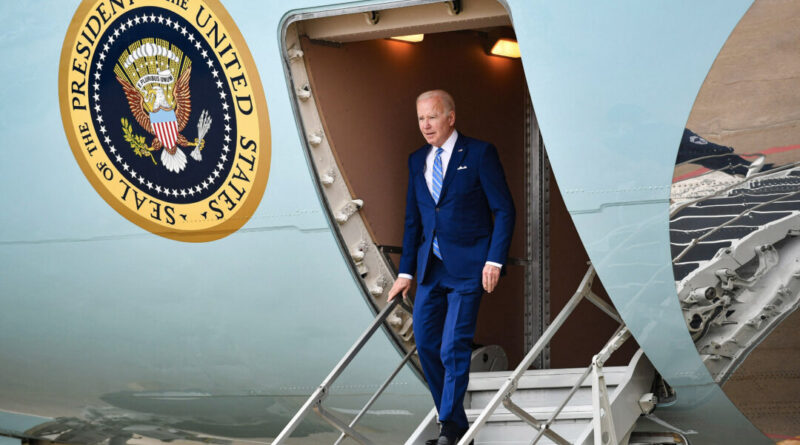Biden’s Aviation Legacy: Infrastructure Investment, FAA Regulations, and Boeing Accountability
Malmquist expressed that Air Traffic Control has faced challenges recently due to a significant number of retirements, putting additional stress on the current staff.
The Biden administration’s era in American aviation is set to conclude on January 20. Over the last four years, President Joe Biden’s administration has facilitated substantial changes that have had a profound effect on air travel across the United States.
The federal government allocated $15 billion for airport infrastructure and $105 billion for the FAA, while also enhancing regulatory oversight and implementing new consumer protection rules.
Following a January 2024 incident where a door plug on a 737 Max 9 blew out, the FAA heightened its scrutiny of Boeing, and the DOJ revived a criminal investigation that began during Trump’s first term.
Under Biden’s new consumer protection rules, airlines are mandated to provide automatic refunds for canceled or significantly delayed flights.
Aviation experts shared with The Epoch Times that Biden is leaving behind a multifaceted legacy on American aviation, characterized by support for labor unions and COVID-19 relief programs that aided a struggling industry.
Among Biden’s ambitious initiatives before taking office, the push for infrastructure funding—especially for land, water, and air transportation—was particularly significant.
To date, the FAA has made $12 billion in infrastructure grant funding accessible to airports across the country.
“These investments are not only creating jobs but also benefiting our communities.”
Capt. Ross Aimer, CEO and spokesperson for Aero Consulting Experts, with over 60 years of experience as a pilot and flight trainer, remarked that numerous airports in the nation were previously “deteriorating.”

A pilot walks past United Airlines planes parked at San Francisco International Airport on April 12, 2020. Justin Sullivan/Getty Images
Aimer emphasized that funding for airport renovations, runway expansions, and the implementation of new technologies aimed at passenger safety have been essential components.
Capt. Shem Malmquist, an airline and aerospace safety consultant with nearly four decades in the field and currently piloting a Boeing 777, recalled how Trump initially underscored the necessity for airport enhancements by noting that U.S. airports were “outdated, antiquated” compared to major international ones.
“For whatever reason, it didn’t really seem to progress during that time. So, it truly is a continuation of the same concept,” Malmquist told The Epoch Times, in reference to Biden’s endorsement of the funding.
“Some of the [U.S.] airports are just excessively outdated, while others are performing better,” he remarked. “I believe larger facilities and expansion are necessary—not solely for safety but also for customer service enhancements.”
Aside from infrastructure funding, Aimer appreciated Biden’s backing of aviation labor unions.
“Unions hold great significance in aviation because … they not only strive for improved wages and job security for employees but also provide support when they encounter safety issues that need reporting,” he said.
Consumer Protections, Relief Programs
The regulations defined significant changes as “departure or arrival times shifting by more than 3 hours for domestic flights and 6 hours for international ones.”

A flight information board shows multiple delays and cancellations in flight departures from Dulles International Airport in Dulles, Va., on July 19, 2024. Roberto Schmidt/Getty Images
Included within these definitions are instances where departures or arrivals occur from a different airport, an increase in the number of connections, downgrades to lower class service, or airport and flight connections that are not accommodating to individuals with disabilities.
Passengers experiencing mishandled baggage reports are entitled to refunds on their checked bag fees if the delivery exceeds 12 hours after a domestic flight arrival or 15-30 hours for international flights.
Additionally, if a passenger has paid for an extra service, such as Wi-Fi, seat selection, or inflight services, and the airline fails to deliver that service, they are entitled to a refund for the associated fees.
These initiatives began during Trump’s administration in 2020 and were continued via the Consolidated Appropriations Act (2021) and the American Rescue Plan (2021), offering financial support to commercial airlines amid an unprecedented decline in air travel.
FAA Reauthorization Act
The shutdown coincided with many air traffic controllers nearing retirement age, and the subsequent COVID-19 pandemic prompted even more to retire.
Air Traffic Control has been facing challenges due to a high volume of retirements in recent years, according to Malmquist, leaving current staff under significant stress.

Air traffic controllers monitor operations using Data Comm, part of the FAA’s Next Generation Air Transportation system, in the control tower at Miami International Airport on March 6, 2017. Joe Raedle/Getty Images
“People will do their best to manage things, but if we overload them, their ability to maintain safety margins becomes compromised,” he stated.
Having an additional controller available during evening shifts can mitigate issues related to fatigue, alertness, and overall situational awareness.
Capt. Richard J. Levy, a retired American Airlines pilot and lead consultant at Aviation Expert Consulting, shared with The Epoch Times that training standards for controllers are equivalent to those for pilots, noting that standards must be met regardless of increased ATC funding.
“So where was the supervision?” Levy questioned regarding various runway near-collisions. “That’s my main concern.”
DOJ Charges Boeing
Boeing’s quality control measures came under renewed scrutiny during Biden’s administration following a significant safety issue involving the 737 Max.
This aircraft has been under public scrutiny since the deadly crashes of the 737 Max 8 in 2018 and 2019, which resulted in the loss of all 346 lives aboard.
Aimer expressed feelings of fear and disappointment over the situation, given his extensive experience flying Boeing aircraft.
“It was incredibly disheartening and disappointing for the company,” he reflected.
Boeing was accused of intentionally concealing the software’s function from both airline pilots training on the new jets and FAA regulators.
The DOJ provided Boeing with a deferred prosecution agreement, worth over $2.5 billion in fines, under the condition that the company maintains compliance by preventing any further incidents for three years post-agreement—January 7, 2021.
However, on January 5, 2024, just two days prior to the expiration of that timeframe, a door panel detached from an Alaskan Airlines flight shortly after takeoff.
This incident raised serious questions regarding Boeing’s safety practices, prompting the DOJ to announce that the company had violated its 2021 agreement.
Boeing’s safety controversies have become a recurring topic in Washington during Biden’s presidency, resulting in multiple Congressional hearings.

Families and friends who lost loved ones in the March 10, 2019, Boeing 737 Max crash in Ethiopia, hold a memorial protest in front of the Boeing headquarters in Arlington, Va., on March 10, 2023. Olivier Douliery/AFP via Getty Images
“That was careless work involving bolts being misplaced, and they weren’t reattached correctly,” Levy clarified. “That represented a significant oversight by everyone involved, but [Boeing is] making efforts to improve.”
FAA Puts Pressure on Boeing
The door panel incident prompted several current and former Boeing employees to come forward as whistleblowers, reawakening the DOJ’s investigation and pushing the FAA to exercise a level of regulatory authority it hasn’t exercised in decades.
FAA Administrator Mike Whitaker swiftly limited the production of Boeing’s 737 Max planes to 38 per month and grounded 170 planes to verify there were no widespread safety concerns.
Moreover, the FAA requested Boeing to submit a 90-day safety and compliance report to confirm the firm had addressed any manufacturing vulnerabilities.
Additionally, the DOJ once again charged Boeing with defrauding the U.S. government, which prompted Boeing to plead guilty months later. Recently, a U.S. District Court judge dismissed the plea deal.
The DOJ “aims to hold the company accountable without driving it out of business,” Malmquist noted. “It is hard to discern how much of it is performative.”
He remarked that the federal government, under both the Trump and Biden administrations, has been treading a delicate balance while prosecuting Boeing; if penalties target executives, “Instead of being forthcoming … they might resort to destroying evidence.”
“Is there a method to ensure accountability without simultaneously causing people to hide information and shred documents?” Malmquist inquired.

Boeing employees assemble 777 aircraft during production at the Everett Production Facility in Everett, Wash., on June 26, 2024. Jennifer Buchanan/Pool/AFP via Getty Images
Oversight Reform
However, aviation experts remarked to The Epoch Times that these enhanced reforms are key features of Biden’s administration, as the FAA had long taken a backseat regarding regulatory oversight.
Recent actions by the FAA, following similar regulatory measures during Trump’s first term related to the 737 Max 8 crashes, indicate a more proactive stance than the agency has historically adopted, according to Aimer.
“Prior to that, the FAA essentially abdicated its responsibility in overseeing Boeing, allowing Boeing to operate freely with the agency’s tacit approval,” he stated.
“While I’m not entirely satisfied … there has been significant progress in quality control.”
Aimer emphasized that Boeing is a “national treasure” and our largest export in terms of dollar value. Therefore, it is vital to regulate and monitor the safety practices of the company within the U.S. aviation system.
“We have a responsibility to assist them in getting back on track since they have undoubtedly fallen off course,” Aimer remarked.
As the FAA collaborates with Boeing to resolve safety concerns and restore the company’s standing in American aviation, Levy defined the government’s role as being both “enforcers and allies.”
“I stand by what the FAA has implemented,” Levy affirmed.
Malmquist characterized the FAA’s efforts concerning Boeing’s safety challenges as a “complex issue.” He stated, “They need to provide thorough oversight.”
Boeing operates “like a large vessel, and changing its course takes time; similarly, the FAA operates at a similar scale,” he explained.
One contributing factor to Boeing’s predicaments has been the decades-long trend in Washington favoring deregulation, operating under the assumption that companies would self-regulate.
This paradigm appears to have shifted with the Biden administration.
“We are observing clear evidence that [deregulation] is ineffective,” he commented, particularly in safety-critical fields like aviation.
“Corporations, especially significant ones, will tend to prioritize maximizing shareholder value, often at the expense of other crucial factors, and this has certainly impacted Boeing,” Malmquist noted.
Aimer also concurred, asserting, “Complete deregulation is impractical in safety-oriented industries. Similar to airlines, we cannot allow them to operate without oversight.”
Malmquist raised the more challenging inquiry of whether the FAA—under Biden or any future president—is doing enough, especially as the Biden administration transitions to another Trump administration.
The pilot shared that during the 1960s, the FAA exercised significantly more oversight over aviation entities.
As time progressed, the agency gradually eased its regulatory powers, which contributed to the current situation with Boeing and its suppliers, where the company was permitted to self-certify specific assembly procedures. This includes protocols related to the 737 Max.
“All these variables intertwine, leading to slow changes that heighten risk over time. The ultimate responsibility to ensure safety falls on the regulator, in this instance, the FAA,” Malmquist emphasized.
With a new president soon taking office and new FAA leadership anticipated, Malmquist questioned, “Will these improvements be sustainable?”




